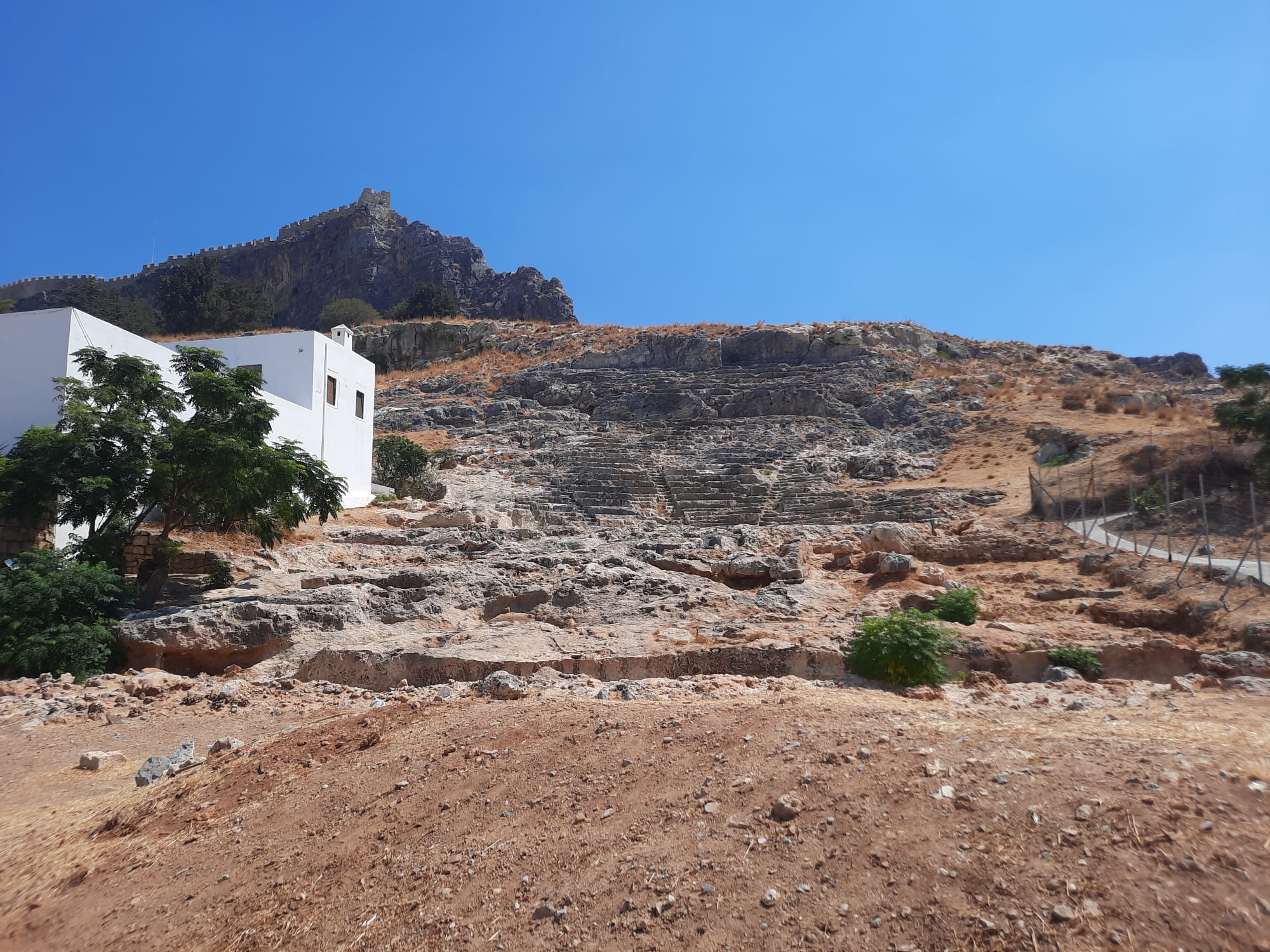Lindos And Its Acropolis, Rhodes
Lindos is a sleepy settlement dominated for millennia by its natural citadel. Or it would be sleepy, were it not for the hordes of tourists descending on it daily (myself included).
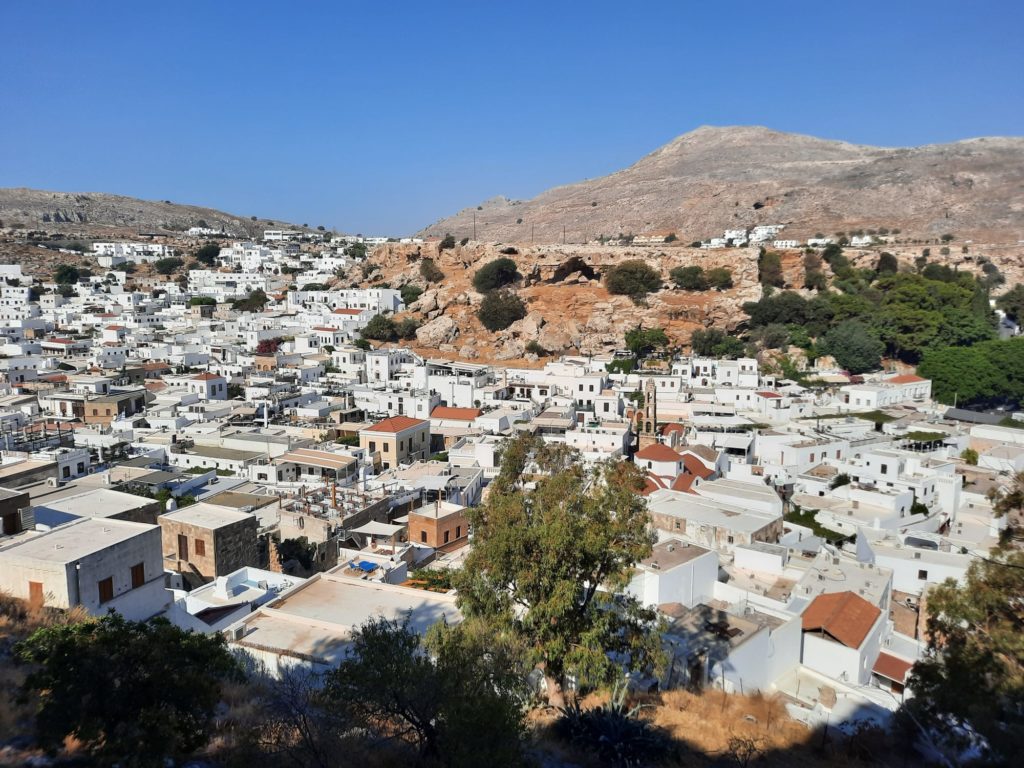
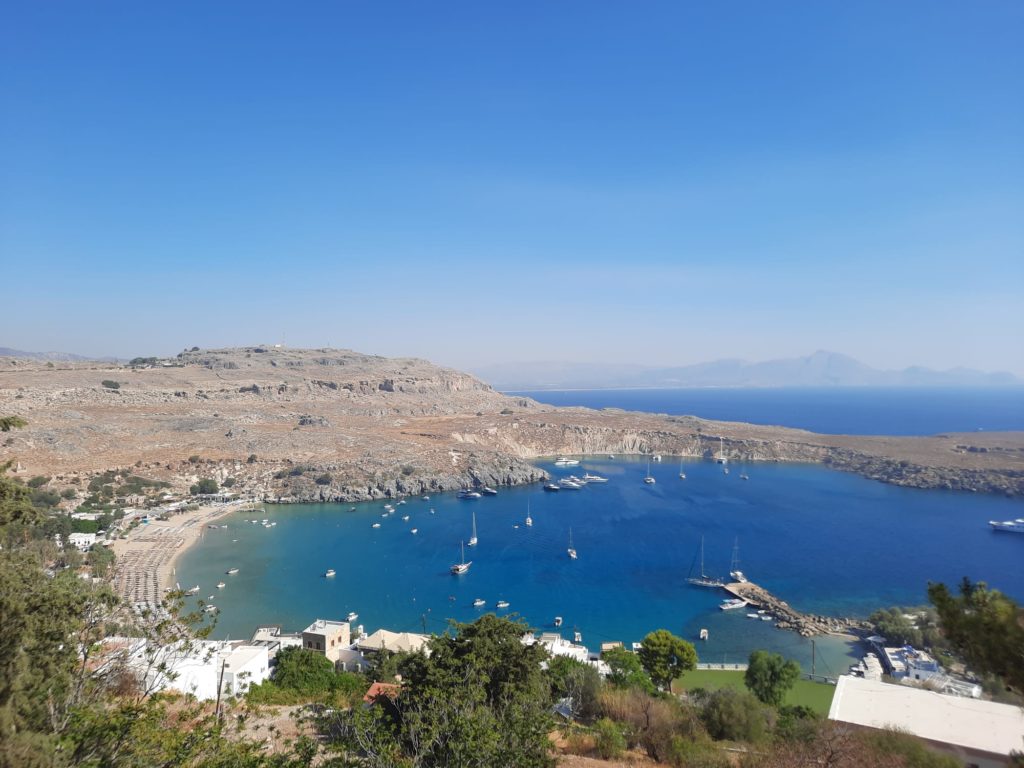
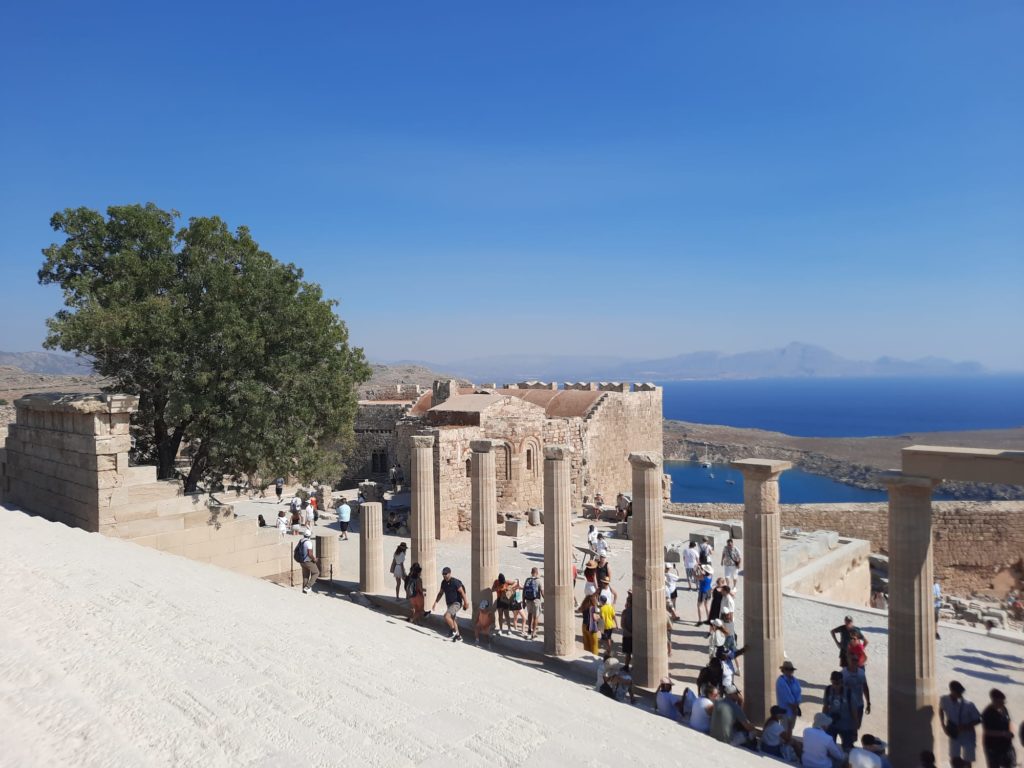
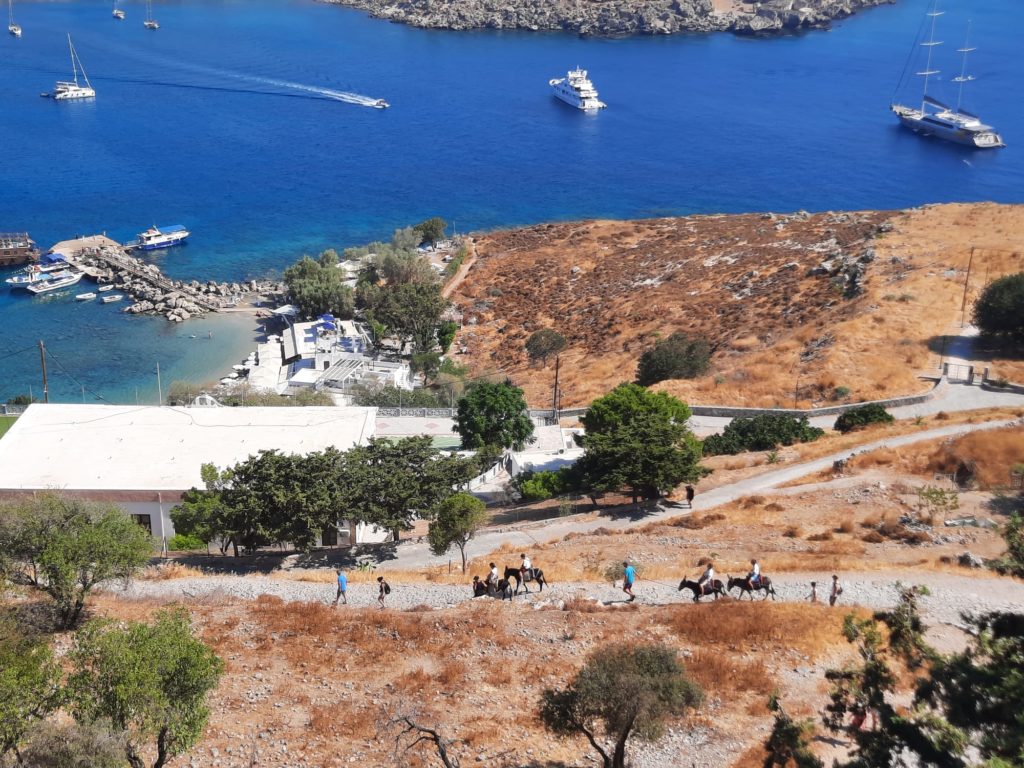
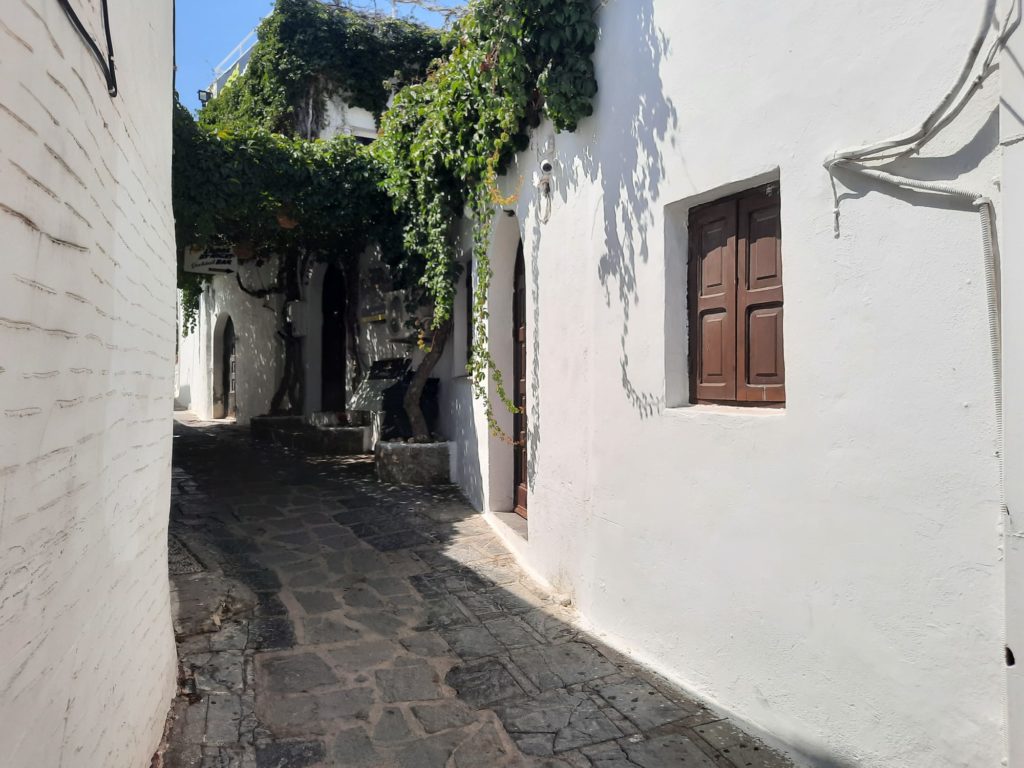
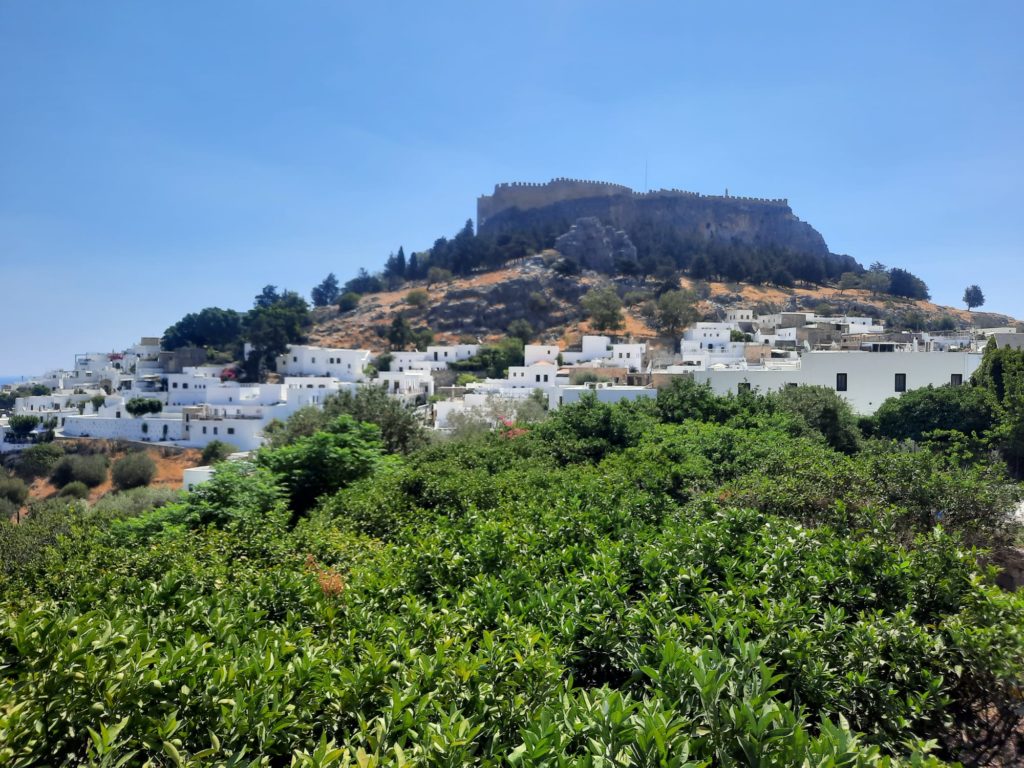
An Introduction to Lindos
Today’s post is very much in the same genre as this one on Cape Verde. It answers the question “what if you’ve booked yourself a nice beach holiday, but still want to get out and see the local sights?” The Salterton Arts Review’s love of history and culture always overrides the urge to sit on the beach. Eventually, at least.
A recent trip to Rhodes was our second. On the first trip, we stayed just outside of Rhodes Town, and did a one day visit to see the sights. It was fabulous: Rhodes was occupied by the Knights of the Order of St John in the Middle Ages, and the Street of the Knights and Palace of the Grand Master are very impressive. But on this trip we chose to see something different, and headed to Lindos. Lindos is on the Eastern side of the island, about 40 KM from the airport and Rhodes Town. Well actually we stayed one bay over, overlooking Vlycha Beach. Not quite being able to see Lindos from our hotel was extra incentive to go exploring.
Once we did, we could easily see why Lindos is one of the most visited places on Rhodes. It has been been occupied for around two millennia: the myth goes that it was founded by King Tlepolemus of Rhodes, a leader in the Trojan War. Whether or not that is true, its easily defensible site overlooking the coastline and harbours made it an excellent spot to build. And its easterly position within Greece meant it was important for trade between Greeks and Phoenicians. Once Rhodes Town was built in the 5th century BCE, however, Lindos began to decline.
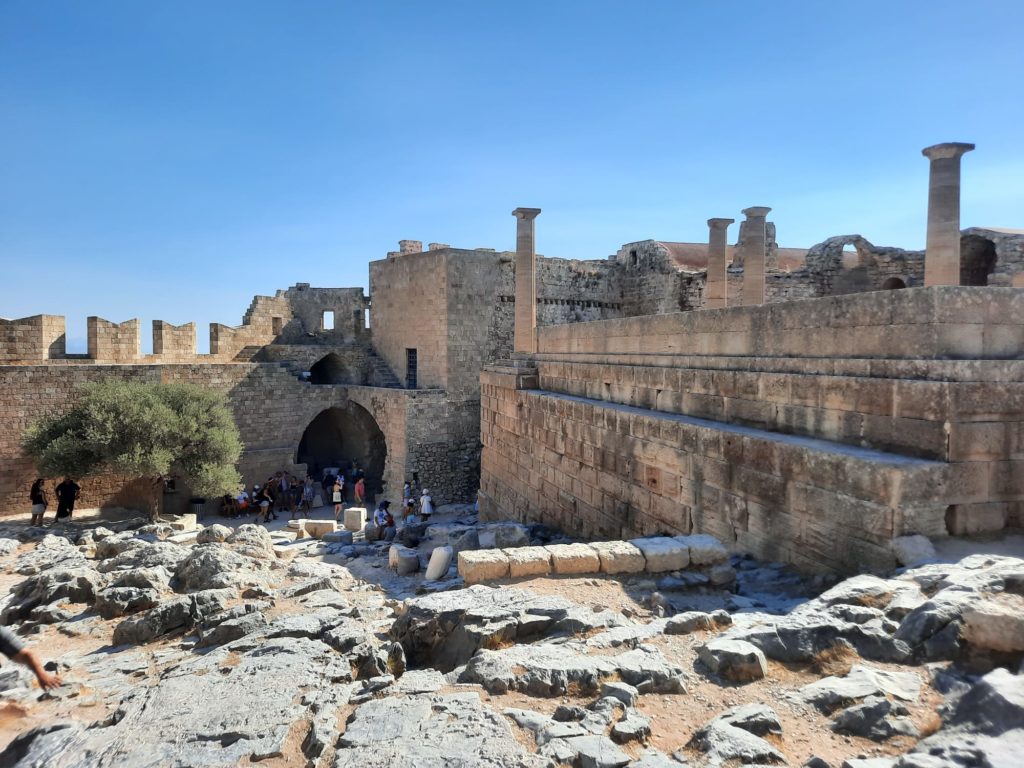
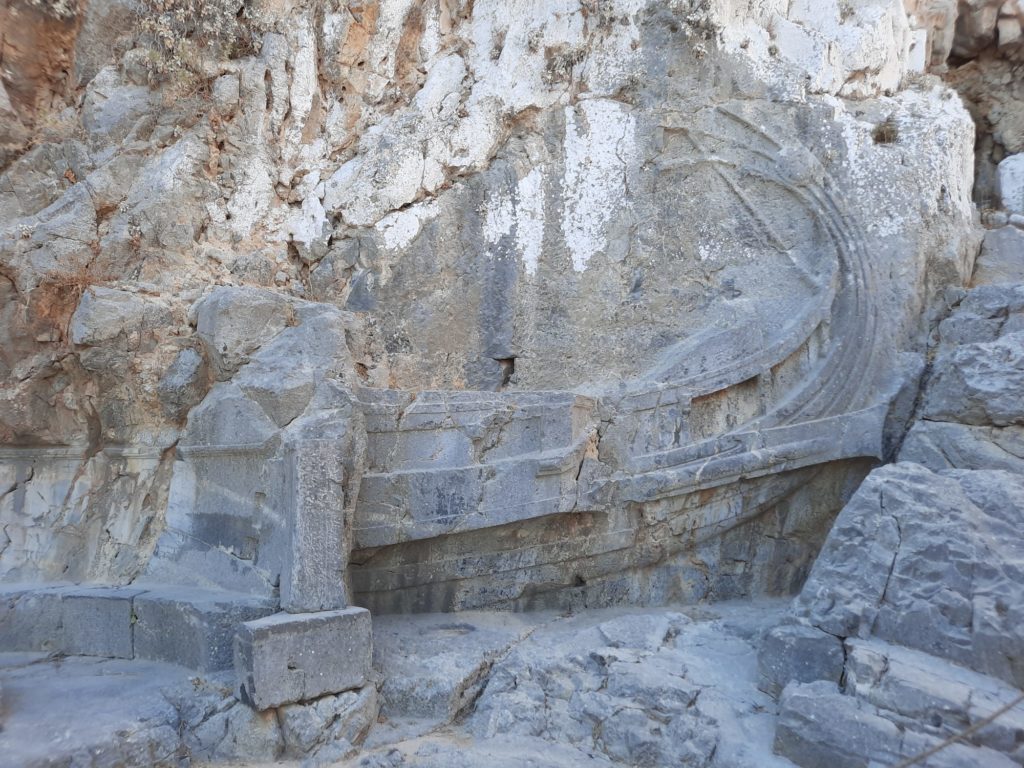
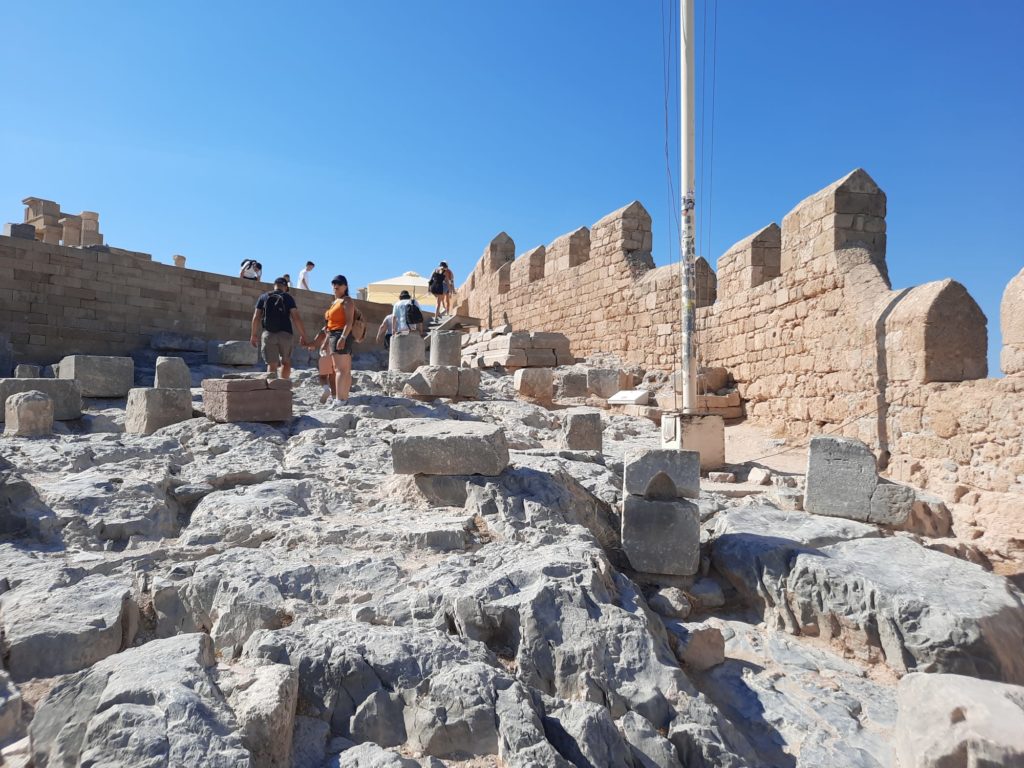
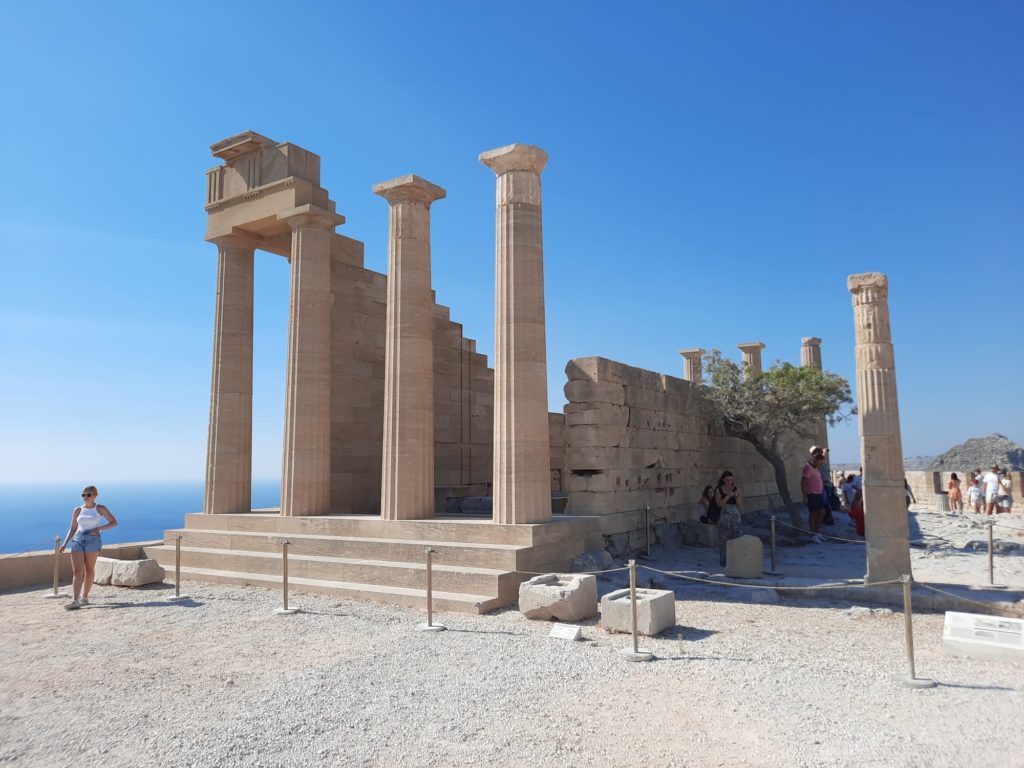
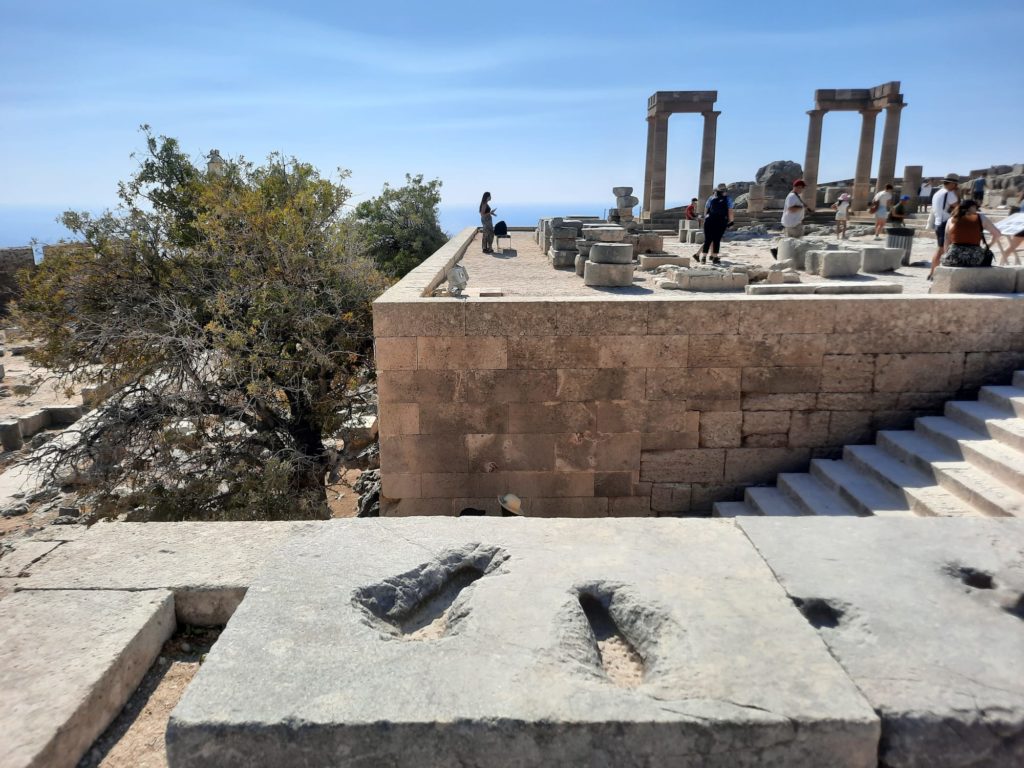
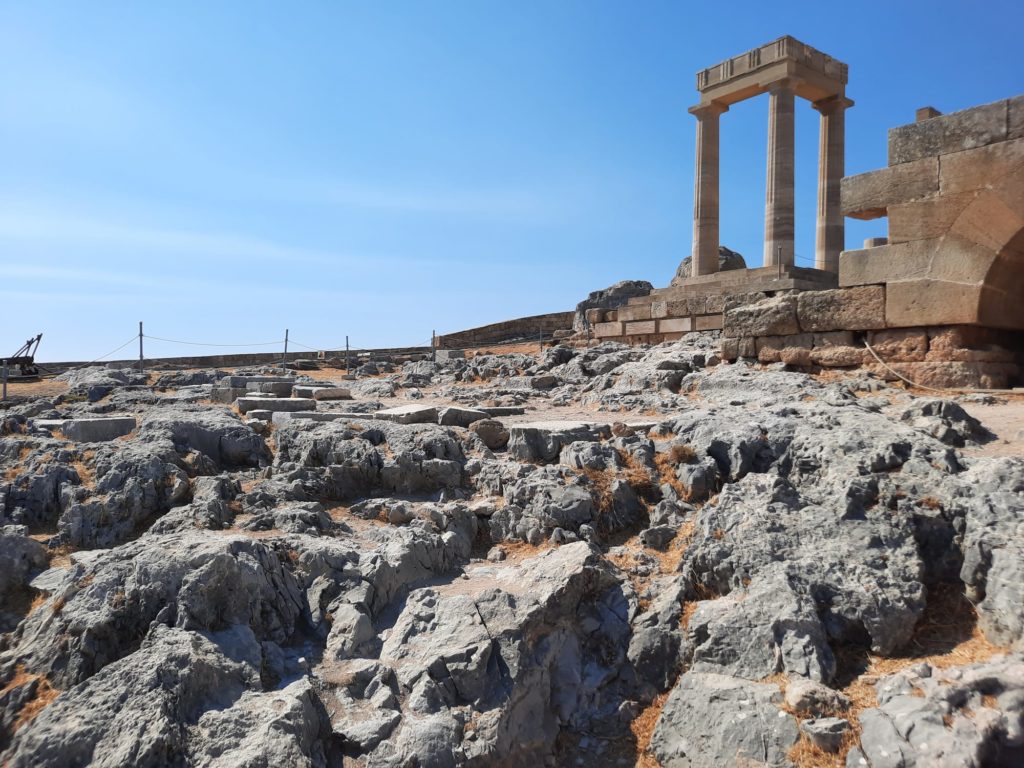
Lindos Acropolis
As I mentioned above, the town of Lindos grew around an easily defensible central site: its Acropolis. An Acropolis is basically a Greek citadel. And a citadel is a fortress on high ground. If you think about the word, the answer jumps out at you: ‘acro’ means high (like acrobat) and ‘polis’ is a town. So a good site up on a hill, easy to see who’s coming and defend your interests and people.
The Acropolis in Lindos reflects the many waves of migration to the island. The Greeks (technically the Dorians) were the first to leave their traces here. They built a huge temple to Athena Lindia at the top of the hill, which reached its final form around 300 BCE. The temple precinct continued to grow in the Hellenistic and Roman period. By the 14th century it was in ruins: a Byzantine church a little further down the hill reflects wider changes to the community here. The Knights of the Order of St John built a large fortress on top of the site to defend against the Ottomans. In the end the Ottomans took over, though, and that Byzantine church became a mosque.
The 20th century left its traces, too. The Carlsberg Institute of Denmark undertook extensive excavations from 1900-1914. Rhodes was also under Italian occupation from 1912-1945. The Italian authorities carried out extensive restoration work. Unfortunately, this was done poorly: elements of the site were rebuilt or re-erected, not always correctly or with sympathetic materials. In recent years Greek and international archaeologists have worked to undo some of the damage.
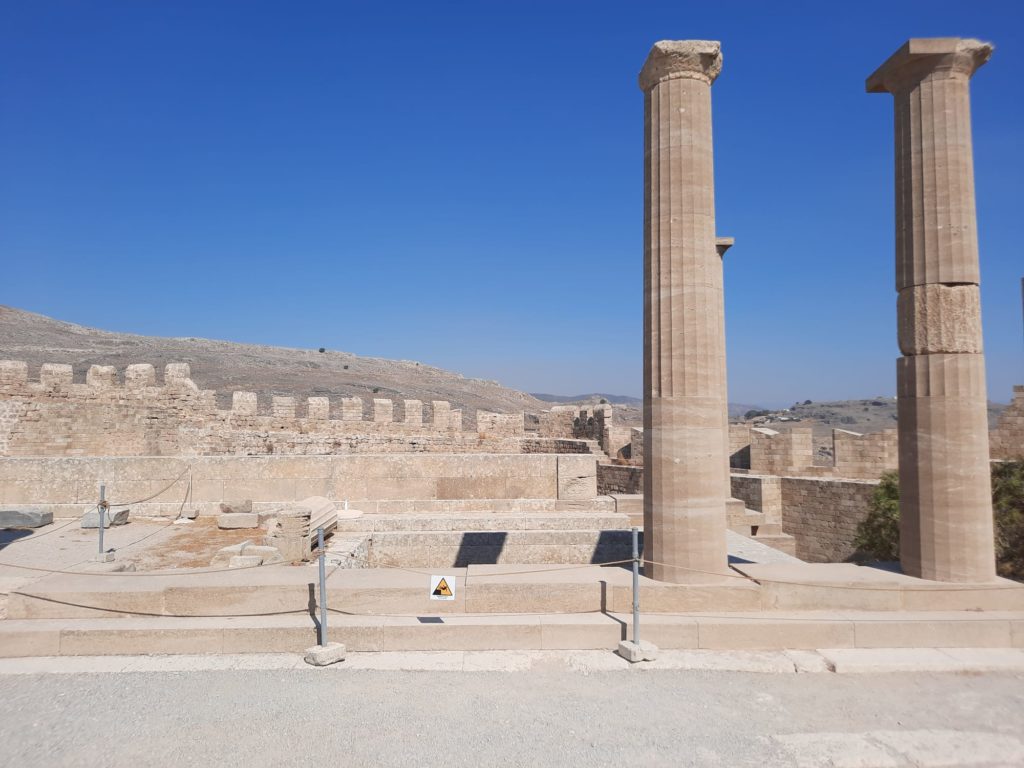
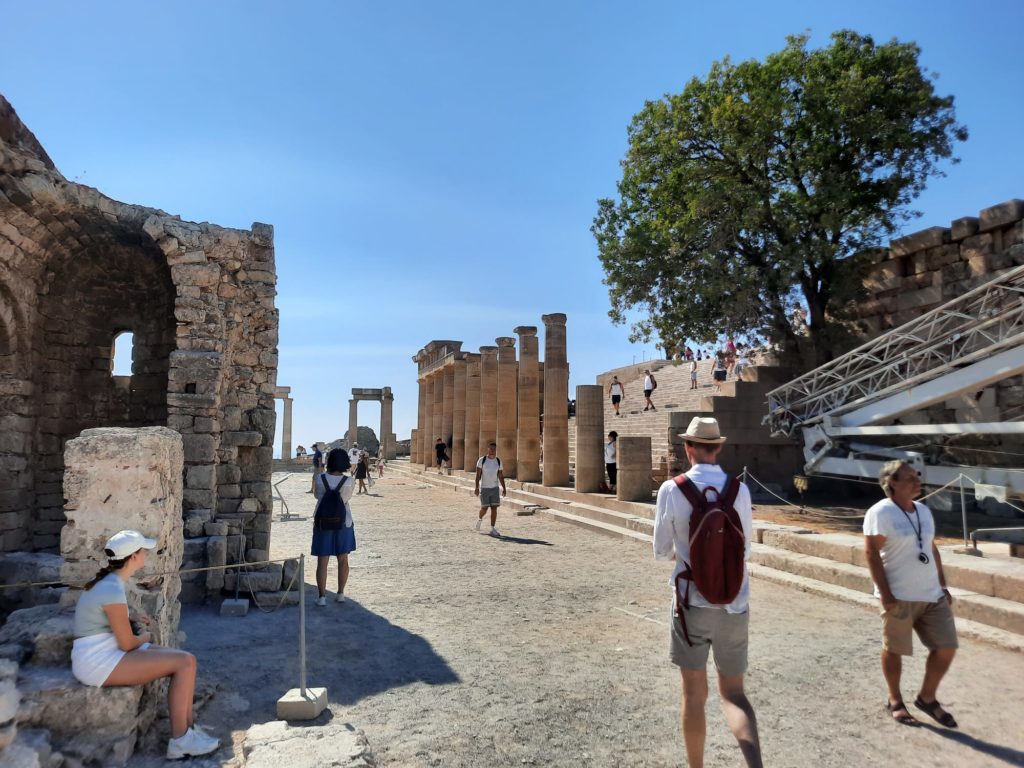
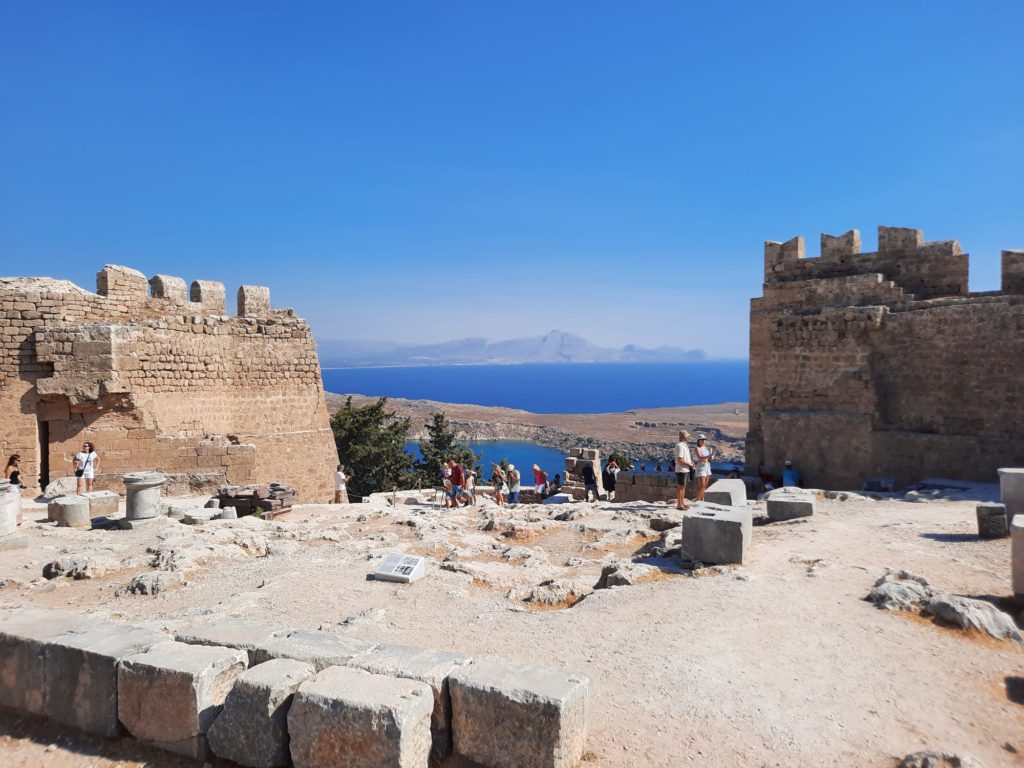
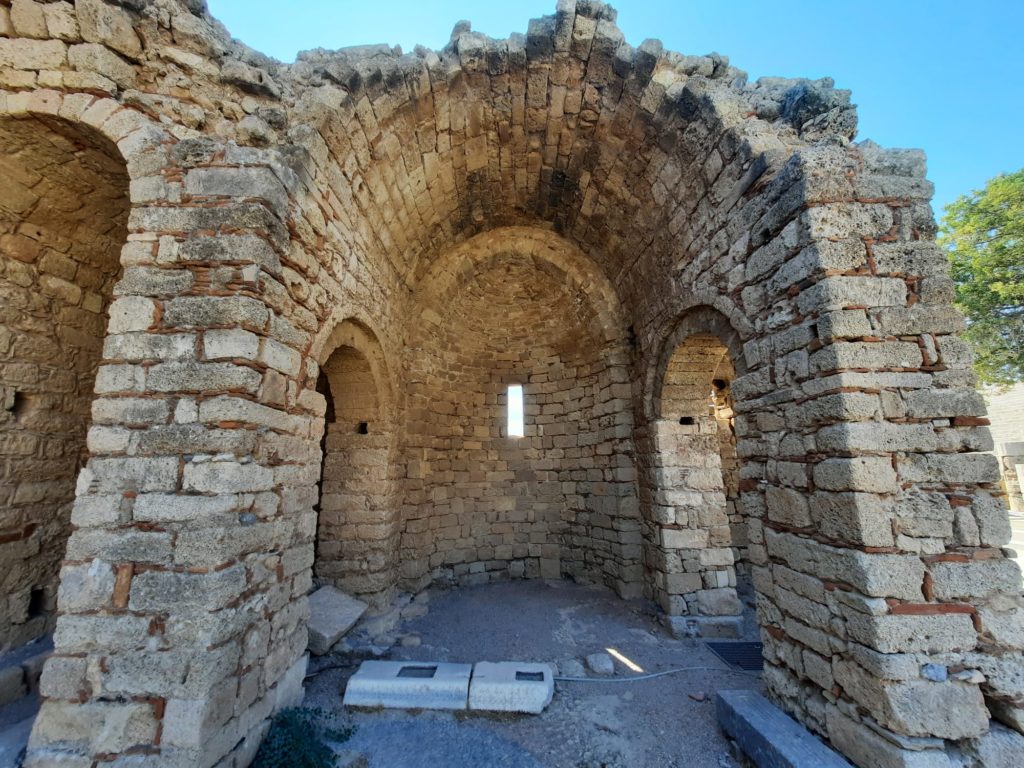
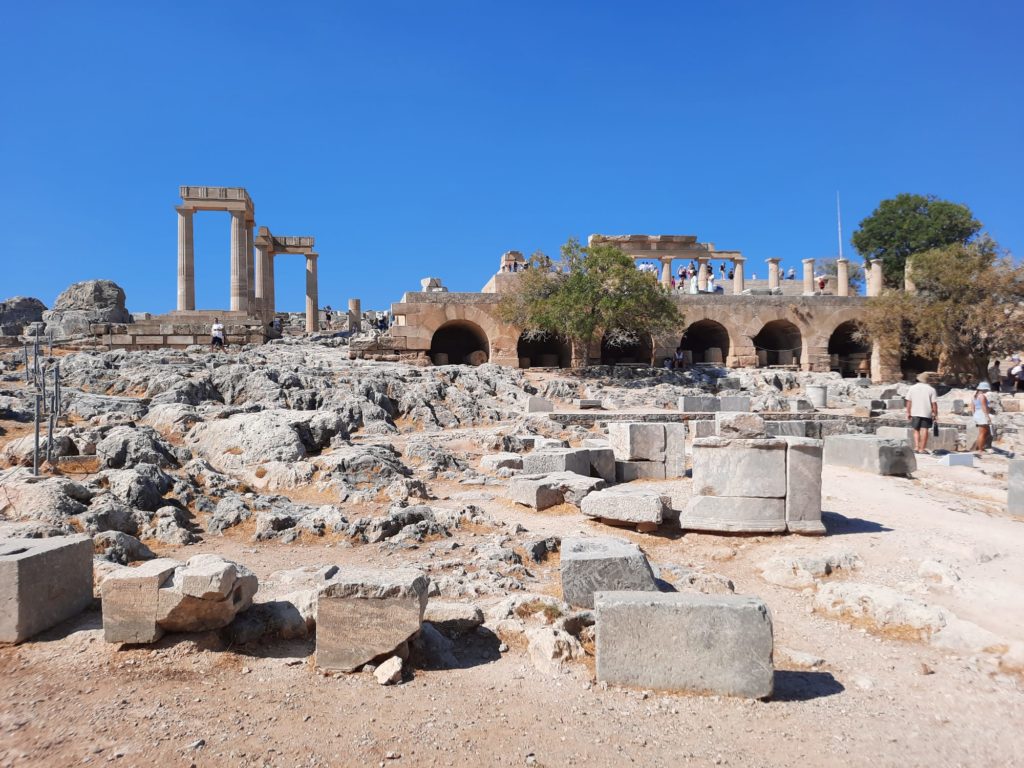
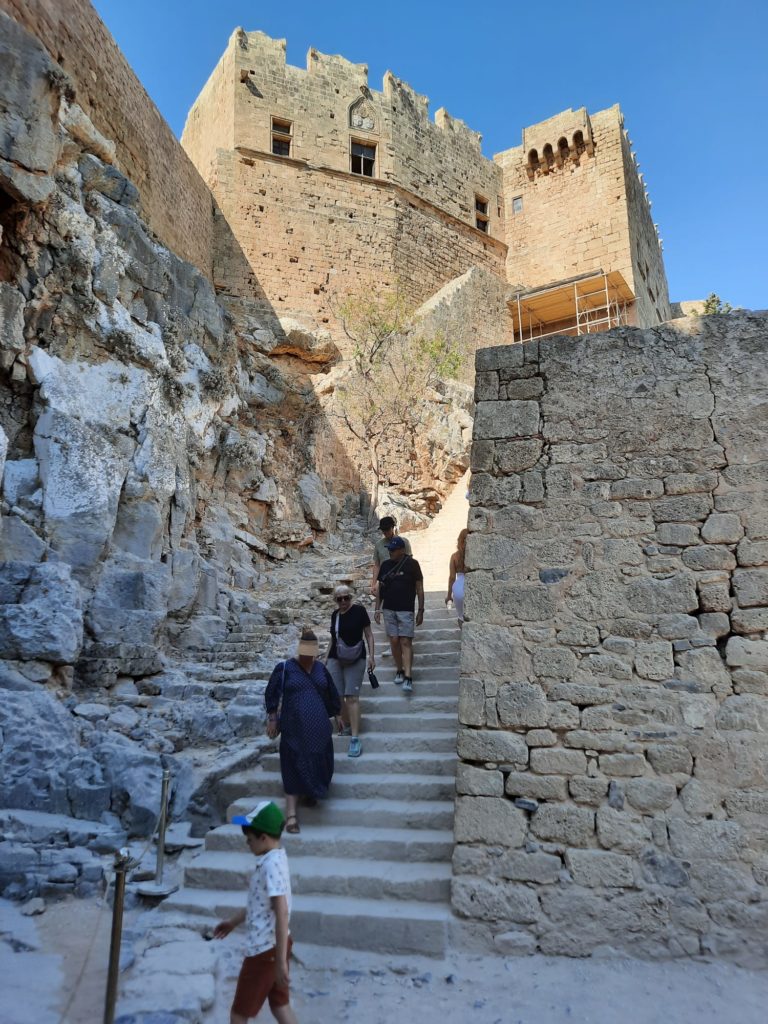
Visiting the Acropolis
A trip to the Acropolis will be the main reason you’re in Lindos. My advice is to go early or late: there is little shelter from the sun once you’re up there. And there is plenty to see: the site is a jumble of all those different historic periods. Two more bits of advice before we set out. Firstly, it doesn’t seem necessary to buy tickets in advance. We were fine buying them on arrival, in August (but again, we were early). And wear sensible shoes. The rocks are slippery, and there aren’t always good handrails or other protections. You don’t want to go flying as we saw one visitor do!
After the climb up through the town, you will come through the ticket barriers to a shady courtyard where you can catch your breath and drink some water before continuing. Take note of the carving of a Rhodian trireme (a warship) at the base of the stairs. A big staircase then leads up through the thick Crusader and earlier Hellenistic walls. The general flow of people will take you over a rocky path and up to the Temple of Athena Lindia. Careful modern restoration work clearly sets out the original vs. replacement stonework. The views from up here are spectacular, over sheltered coves and poor old donkeys lumbering under the weight of tourists who hired them from the main town square.
Once you’ve taken in the temple, you will start working your way back down the site. There is a large Hellenistic Propylaea of the Sanctuary and stoa. A propylaea was a monumental gateway that divided the secular and religious parts of a settlement. So in this case we have come through backwards: citizens of Lindos would have passed through here to access the Temple of Athena Lindia. A stoa was a covered walkway, normally with columns. Then there is the Greek Orthodox church (later a mosque), dating to the 13th or 14th century. It’s in ruins, but you can clearly see the curves of the nave. Finally you pass through more of the fortress of the Knights of St John before clambering back down the stairs towards the exit.
How long you stay exploring the Acropolis is up to you. It’s probably partly dictated by the weather, and how long you can stand the direct sunlight. There are a number of interesting interpretation panels to read for archaeology lovers like me. And the bird’s-eye view is great for watching the people and boats below. I liked lingering over some of the engraved stones, and the former pedestals of statues, now bearing only ghostly footprints.
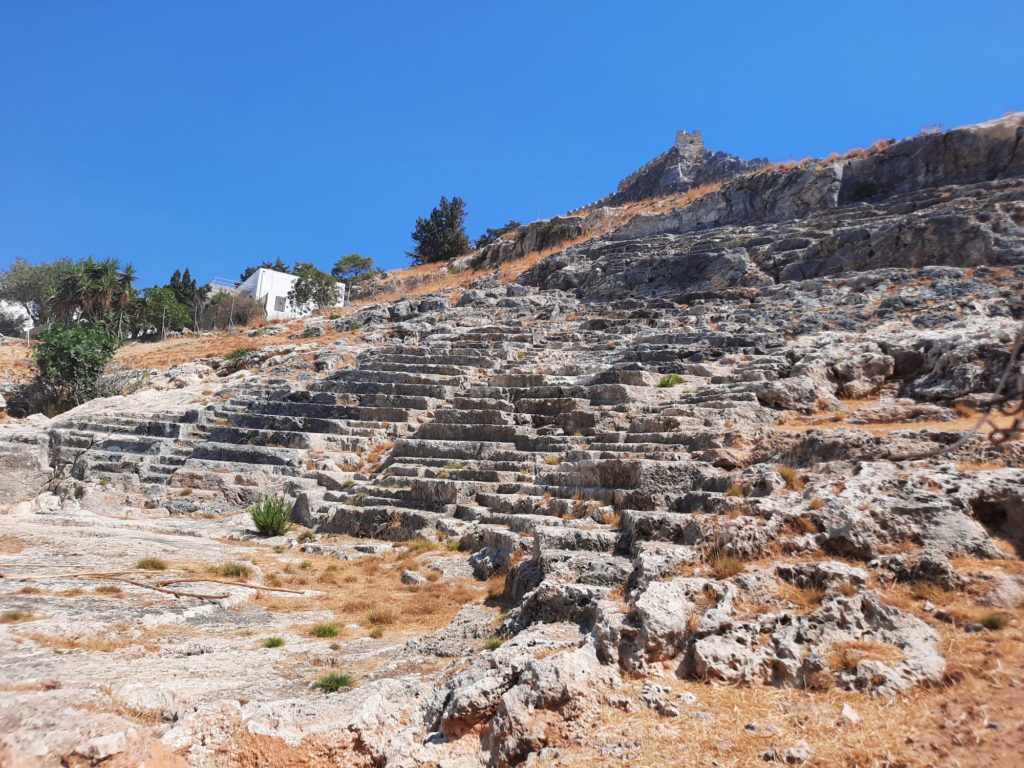
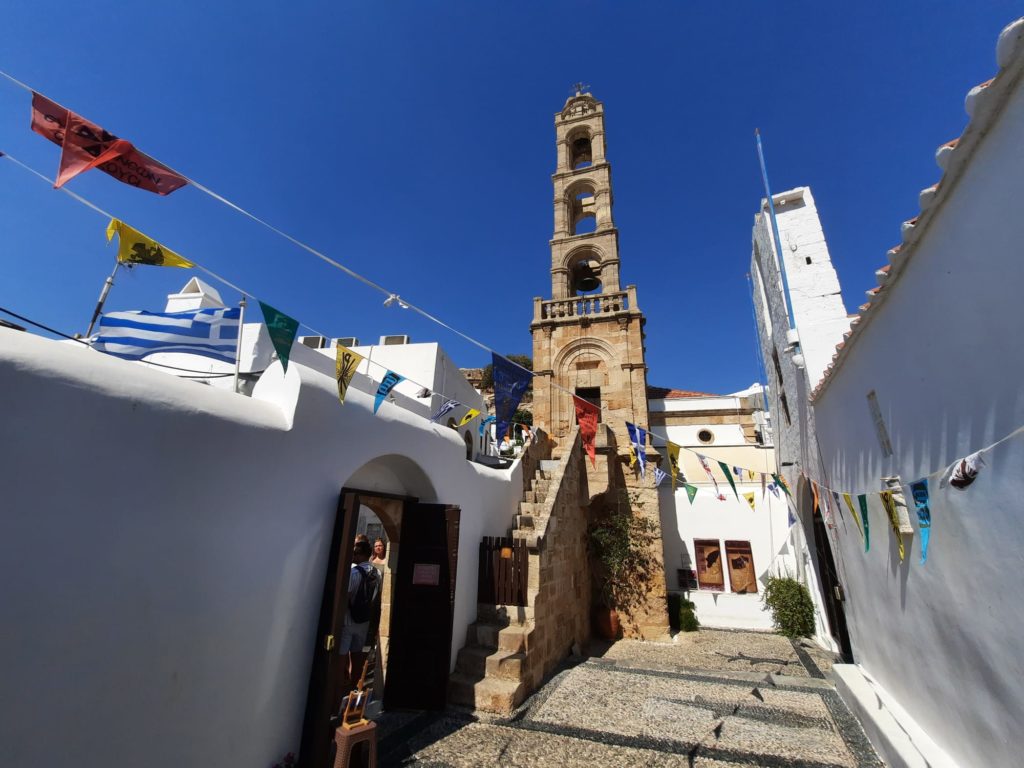
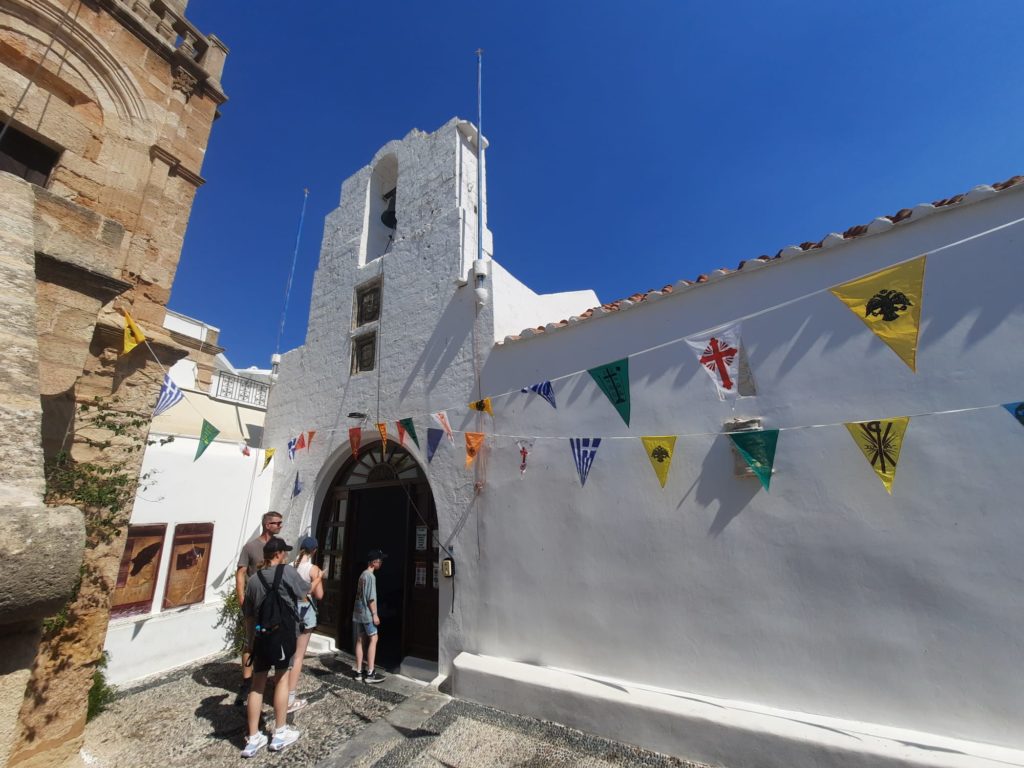
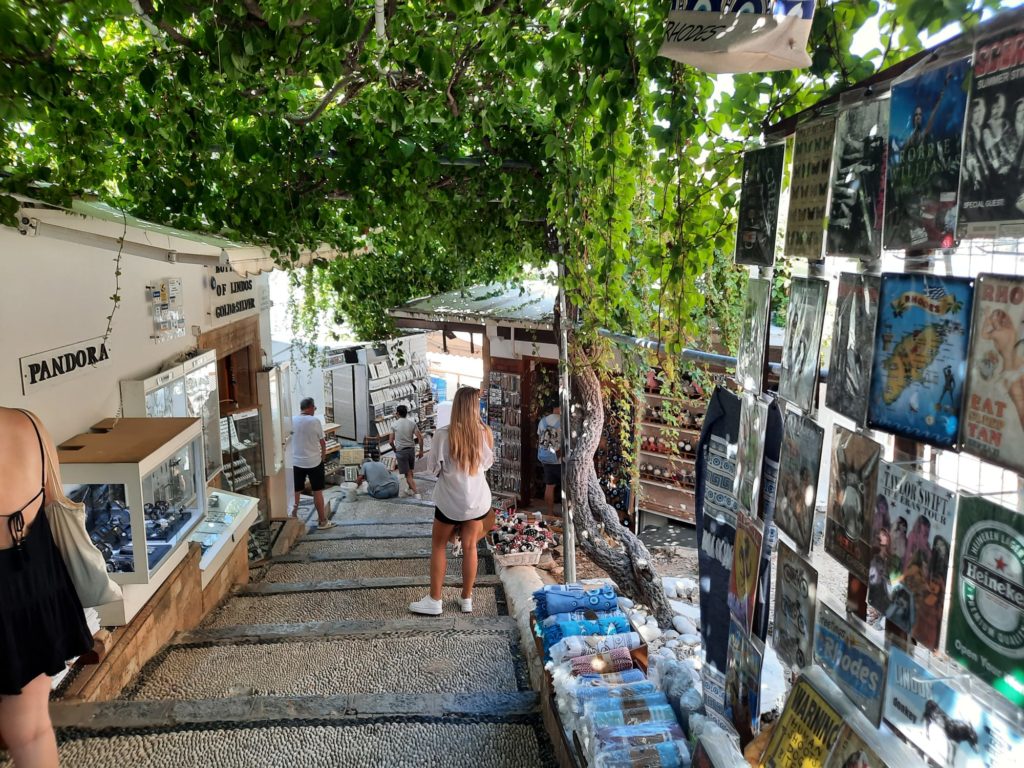
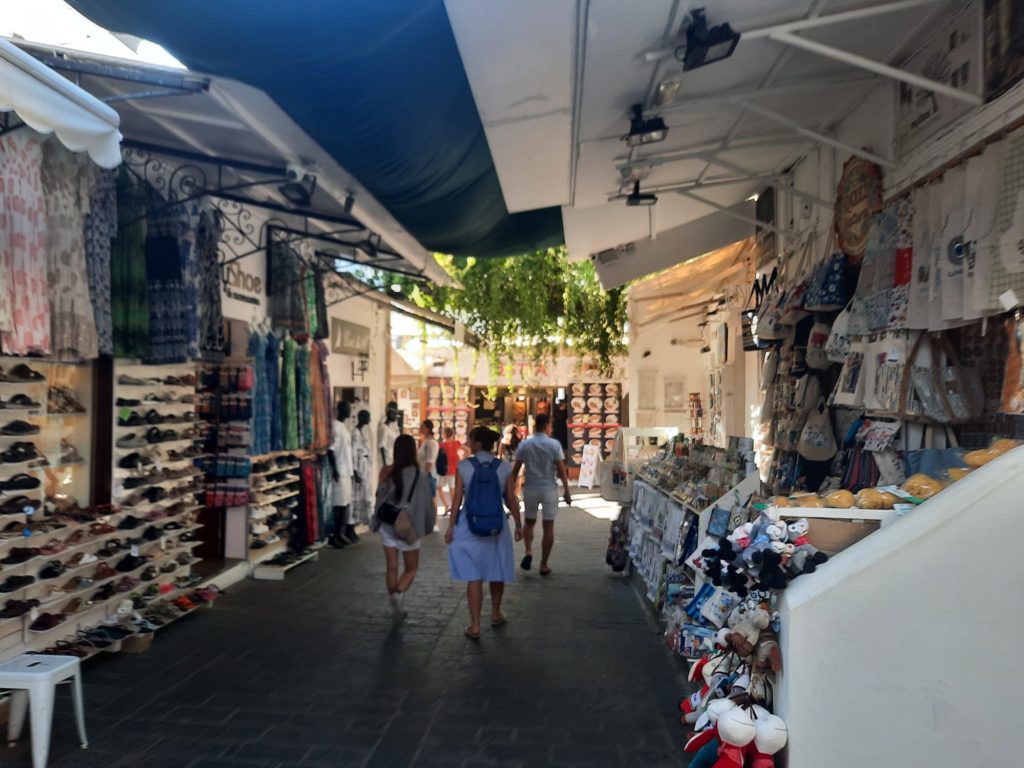
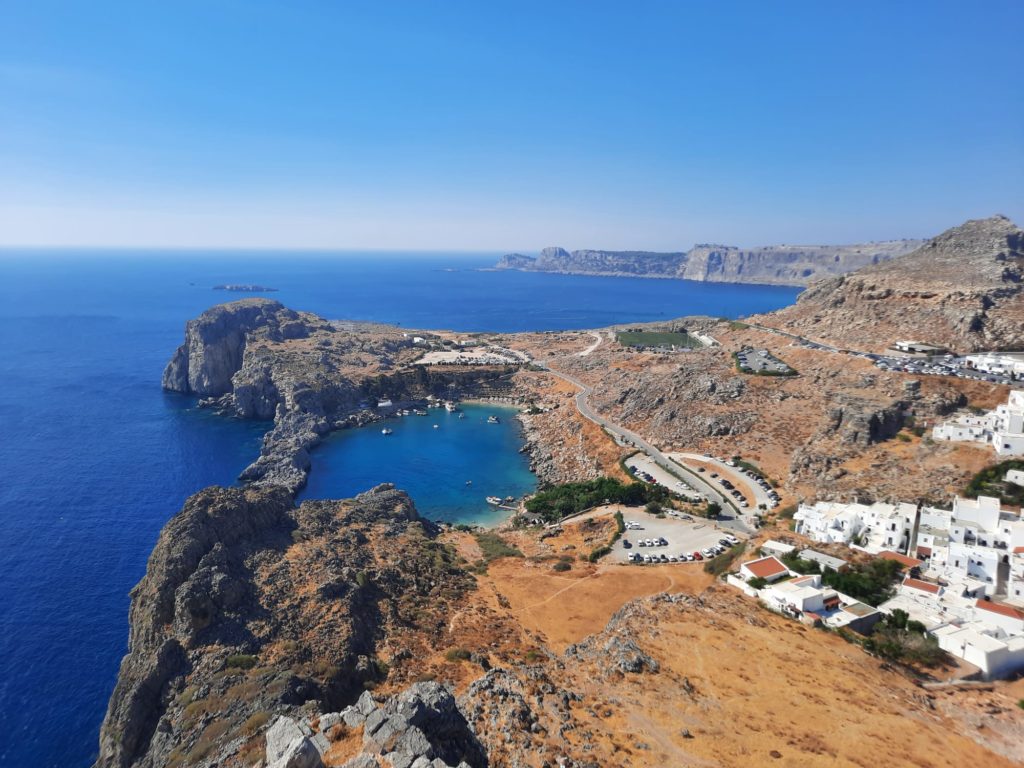
Other Things To See and Do
It’s hot work checking out the Acropolis, so you’ll likely want to pause for a cold drink afterwards. So does everyone else, so every other shop will offer you fresh orange juice. It might be at tourist prices but is still refreshing, so please make your decision accordingly.
After we had rested for a while, we had two other sites we wanted to check out. One was the Byzantine Church of Panagia (Our Lady). There is an entrance fee, and no photography allowed inside. It has the sort of highly decorated interior you would expect from an Orthodox church, with paintings and icons everywhere. The smell of incense is very atmospheric, even if the music is piped in. And a small museum houses some interesting objects and manuscripts.
Then we made our way to the other end of town to the Ancient Theatre of Lindos. As often seems to be the case, the amphitheatre was nestled below the citadel. Dating to about 400 BCE, there was originally capacity for around 2,000 people. It is linked to local festivals celebrating Dionysus, the Sminthia. You can’t get up close to the theatre but can see it sufficiently well through a perimeter fence.
We had had our fill of sightseeing by this point, but there are a few more activities on offer:
- Traditional House Museum of Lindos 18th Century. Just past the Church of Panagia, this museum shows what life was like here in the 18th century. It seems interesting, and if I hadn’t run out of steam by this point I would have liked to see it.
- Shopping. Like a lot of Greek towns and villages, most of Lindos consists of winding alleys. And a lot of these now cater to tourists, with a lot of shops and restaurants.
- Swimming. Looking down from the Acropolis, some of the swimming spots around Lindos look top notch. For my money, St Paul’s Bay looks lovely and sheltered.
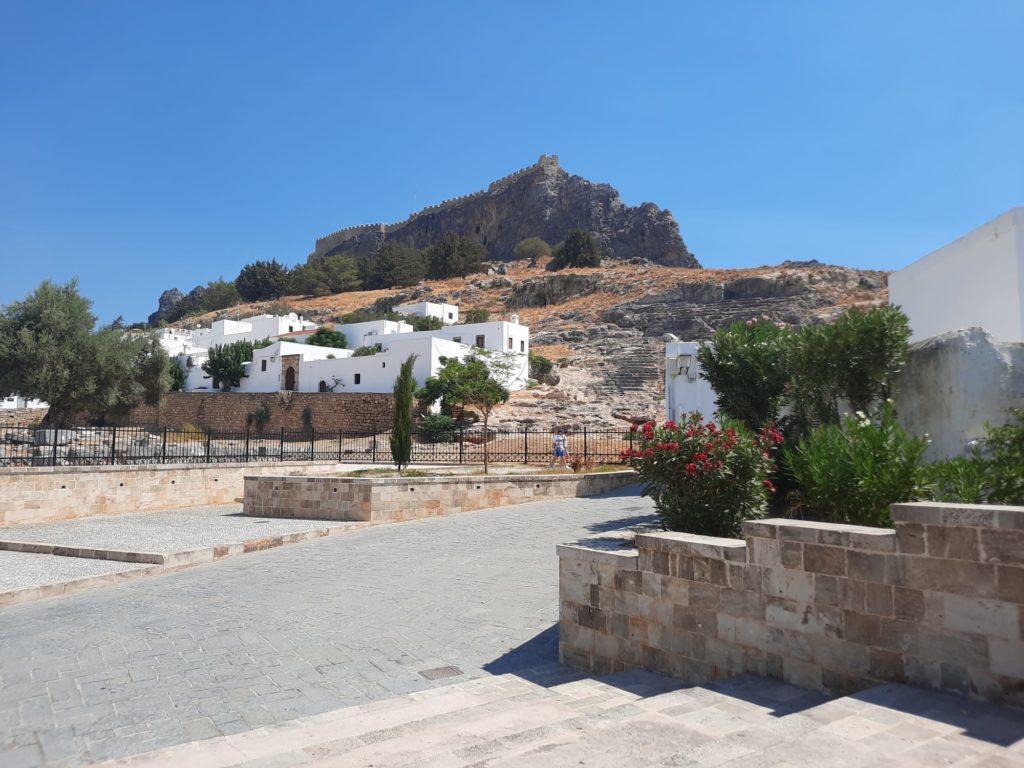
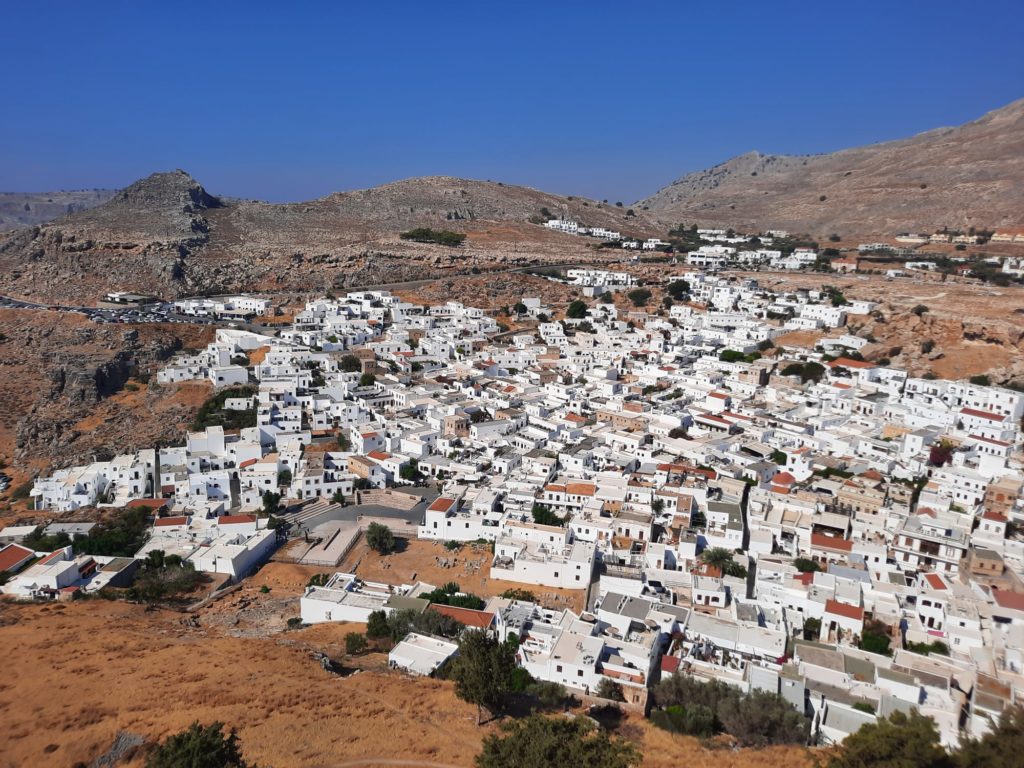
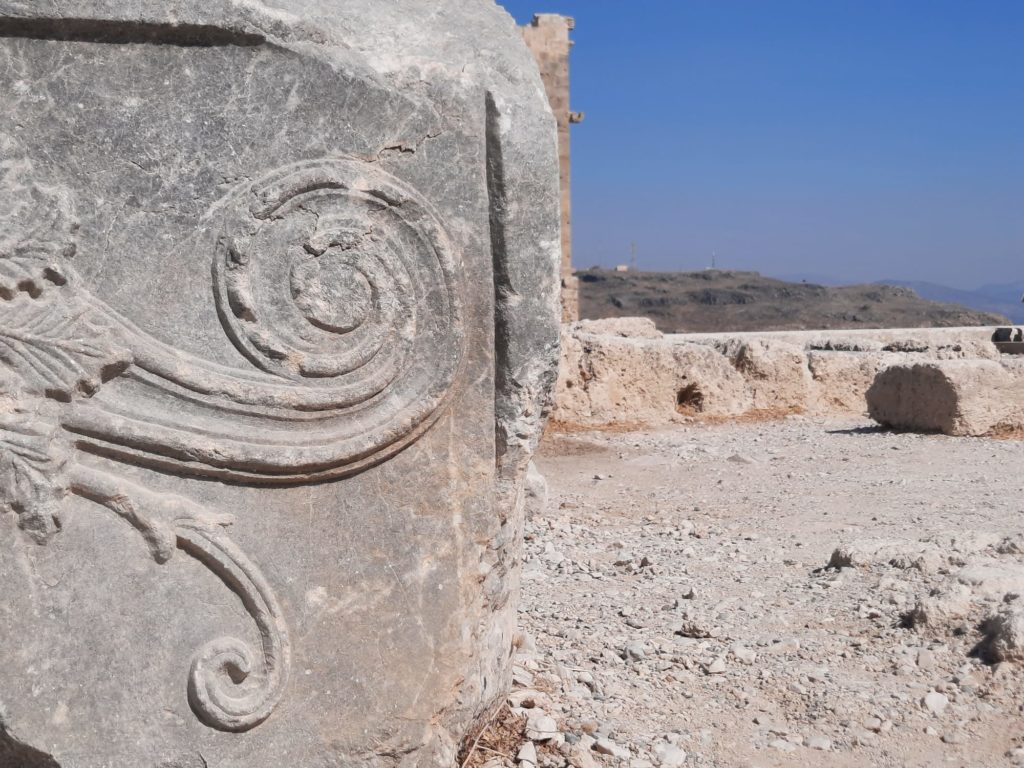
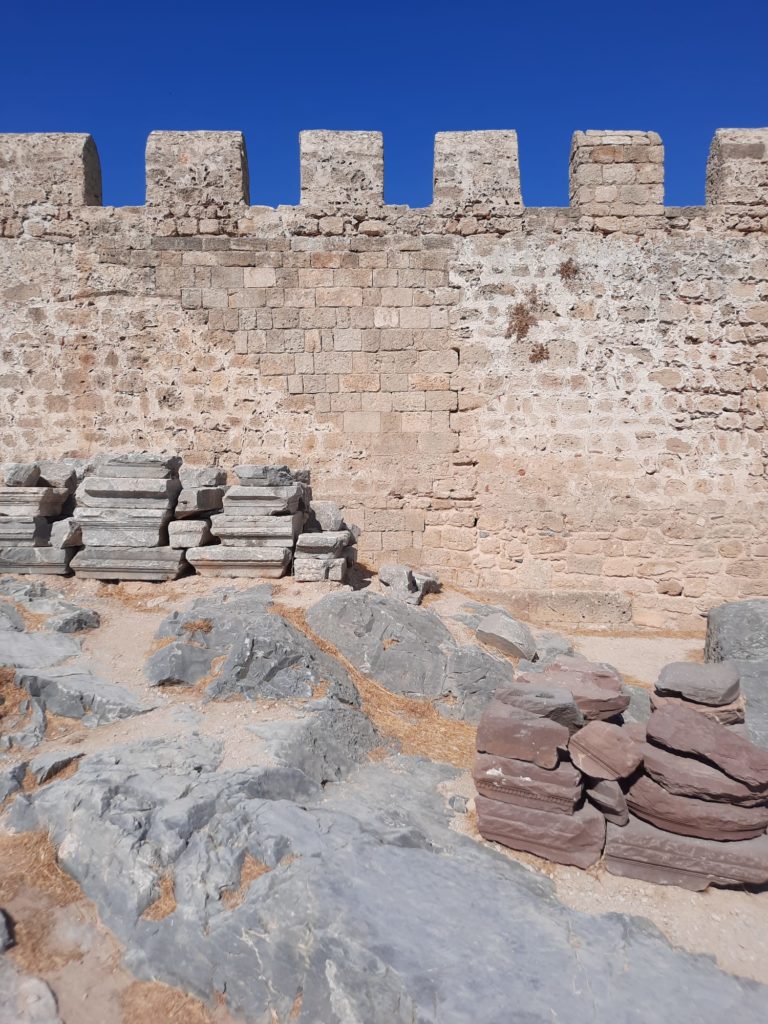
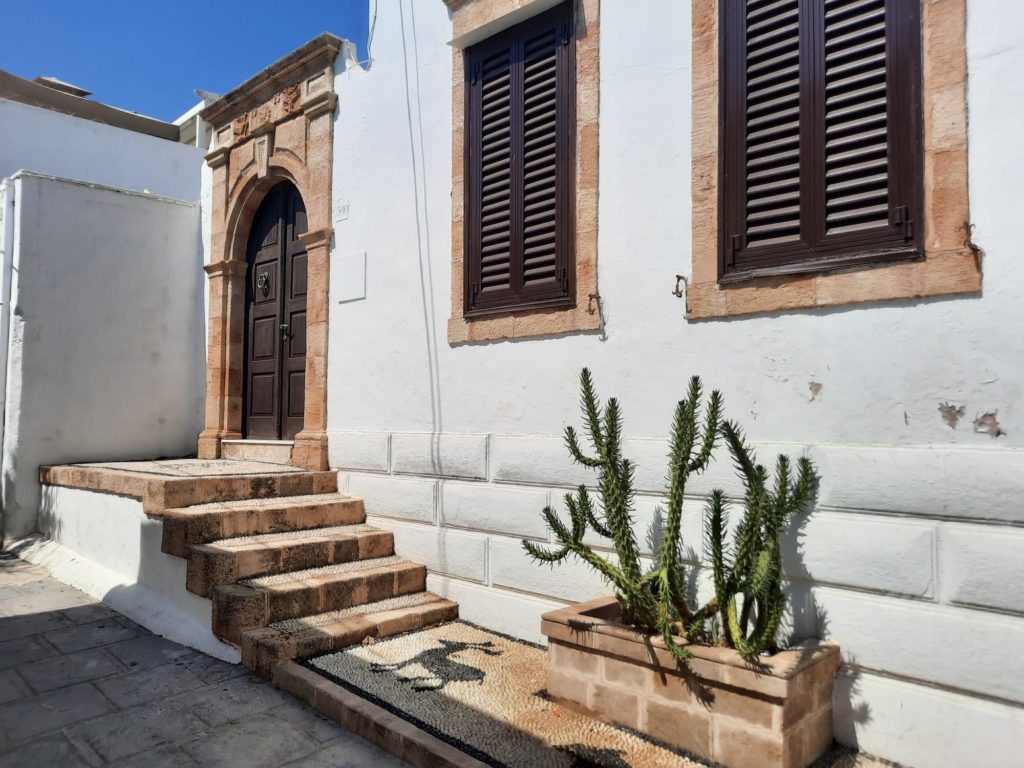
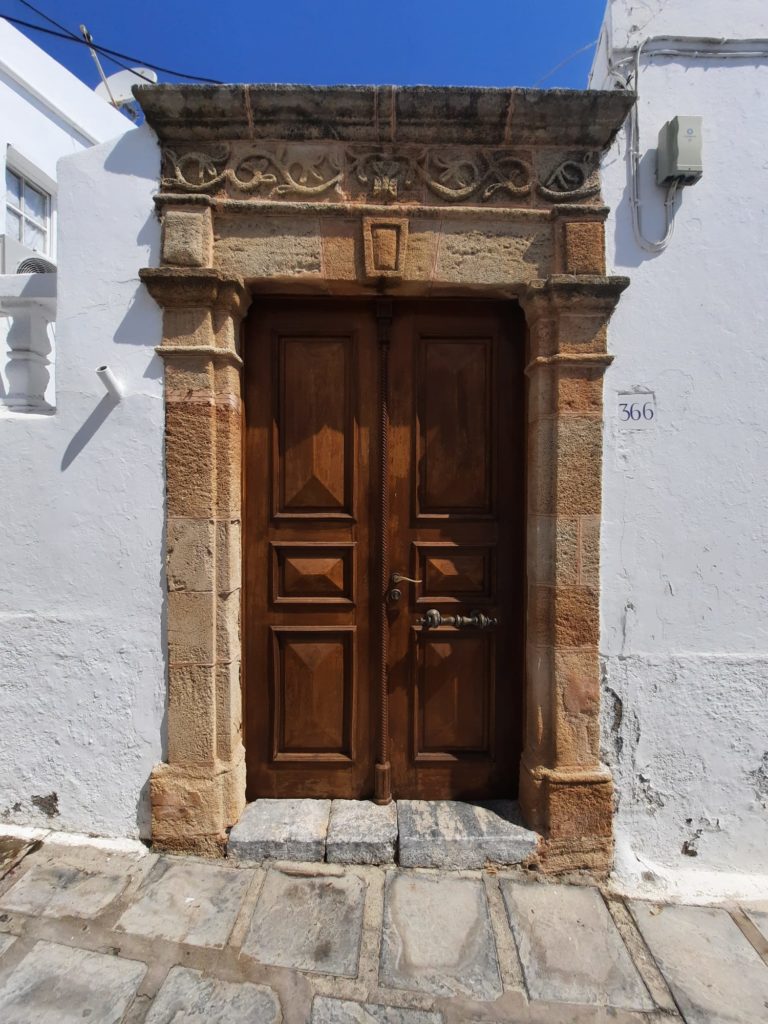
Final Thoughts on Lindos
As lovely as our short trip to Lindos was, it was lovely primarily because we got there early. When we arrived, it was a pleasant stroll from the main square where our taxi dropped us off, through the town and up to the Acropolis. A couple of hours later we were fighting our way through busloads of tourists, and joining a free-for-all to get a taxi back up the hill. So if you can, visit either early or late in the day. This will also have the benefit of avoiding the heat of the day.
Having said that, if you’re able bodied then the walk up to the Acropolis should be very manageable. Please think carefully before procuring the services of a donkey to take you up. If it’s too hot for tourists, presumably it’s also not much fun for donkeys with tourists on their back. Just make sure you have some water with you and you’ll be fine. Oh, and watch out for the traditional pebble-decorated streets: don’t forget those sensible shoes I recommended.
I don’t want all that to put you off, though. The reason that busloads of tourists come to Lindos is because of how lovely it is. That setting, with the ancient Acropolis rising above the whitewashed fishing village, is dramatic and oh so Greek. By planning ahead, taking your time, and stopping for breaks when you need them, you can have a pleasant and relaxing visit to Lindos. Even better if your hotel is nearby and you can look forward to a dip in the sea at the end.
Trending
If you see this after your page is loaded completely, leafletJS files are missing.

